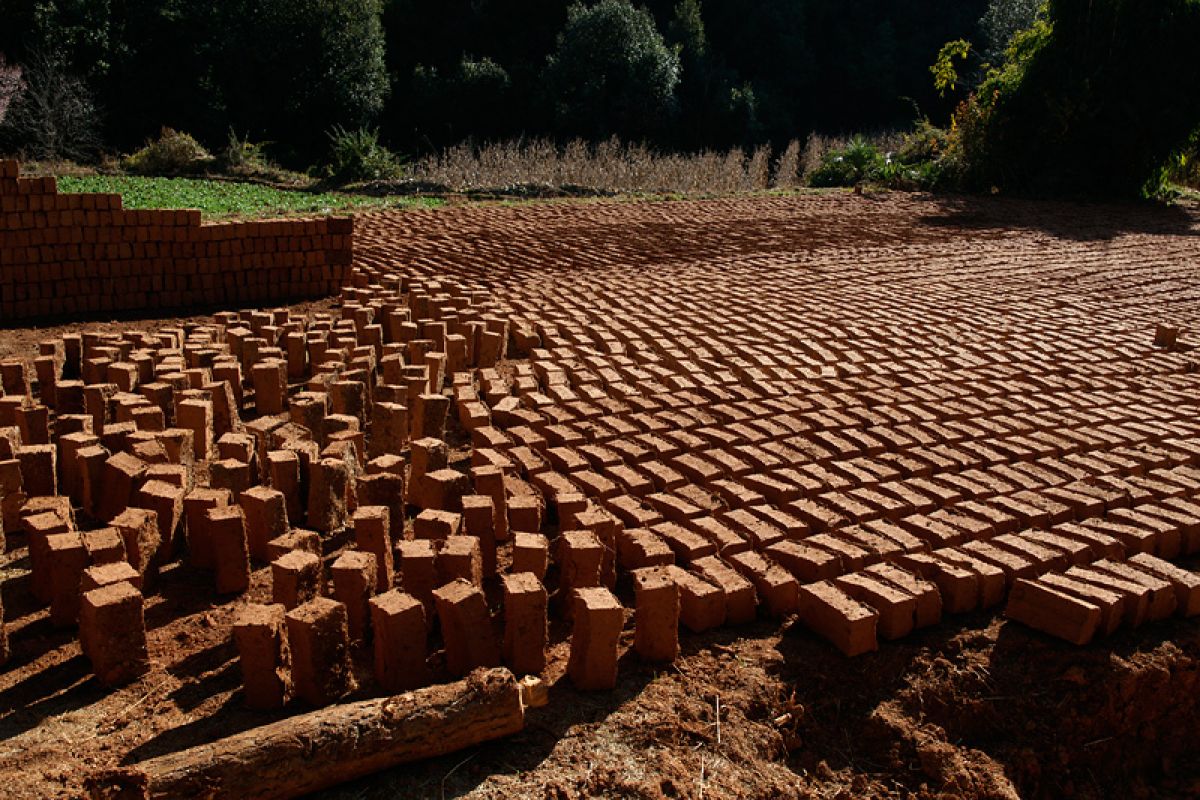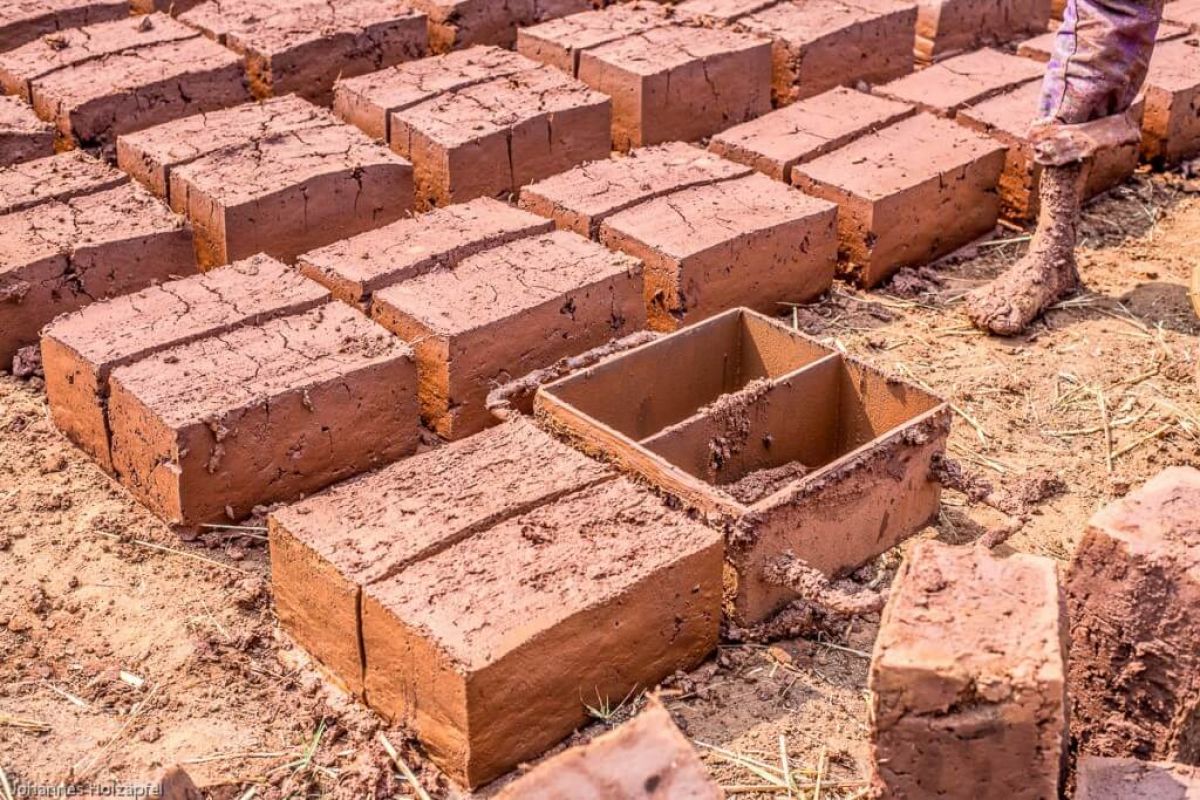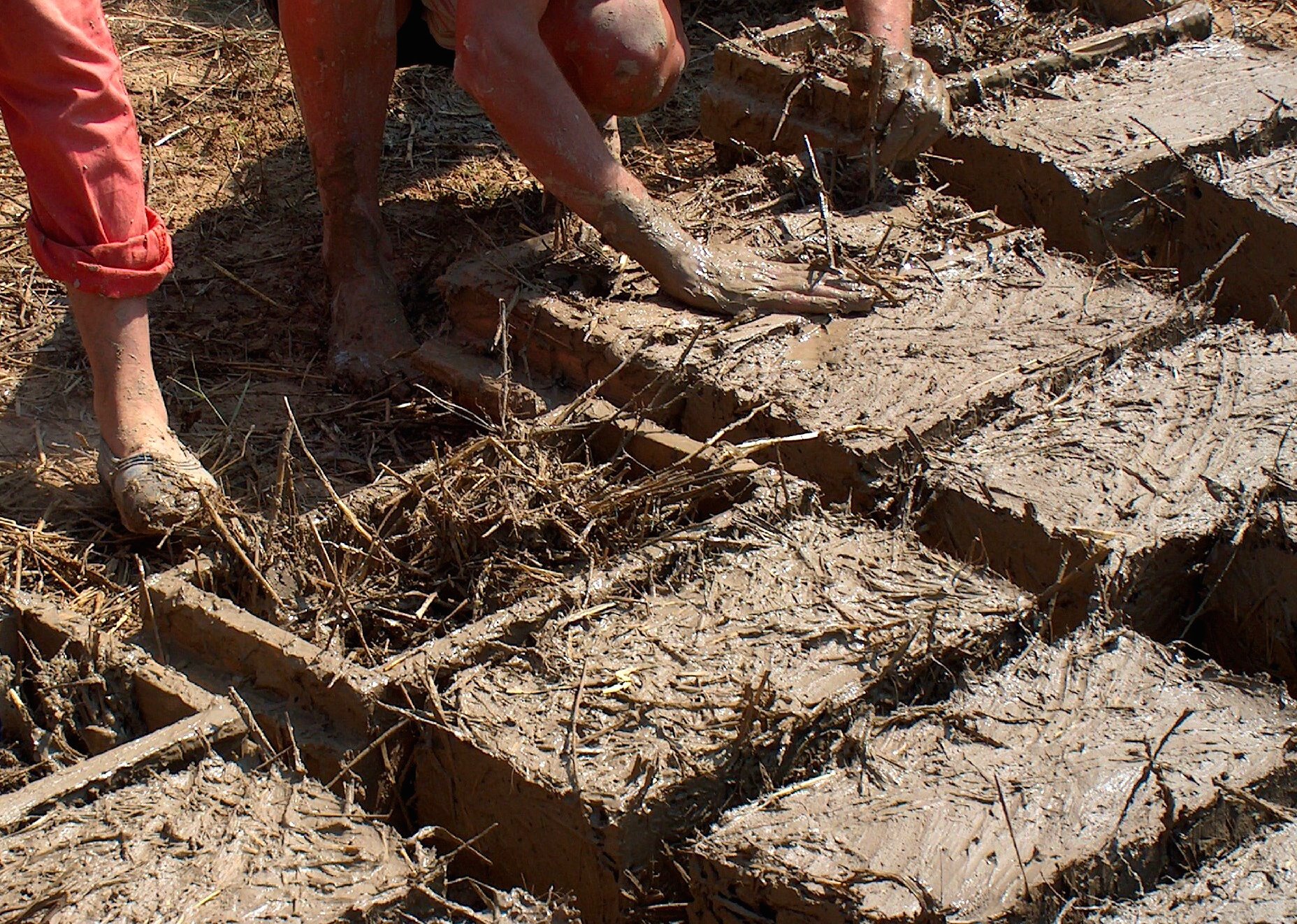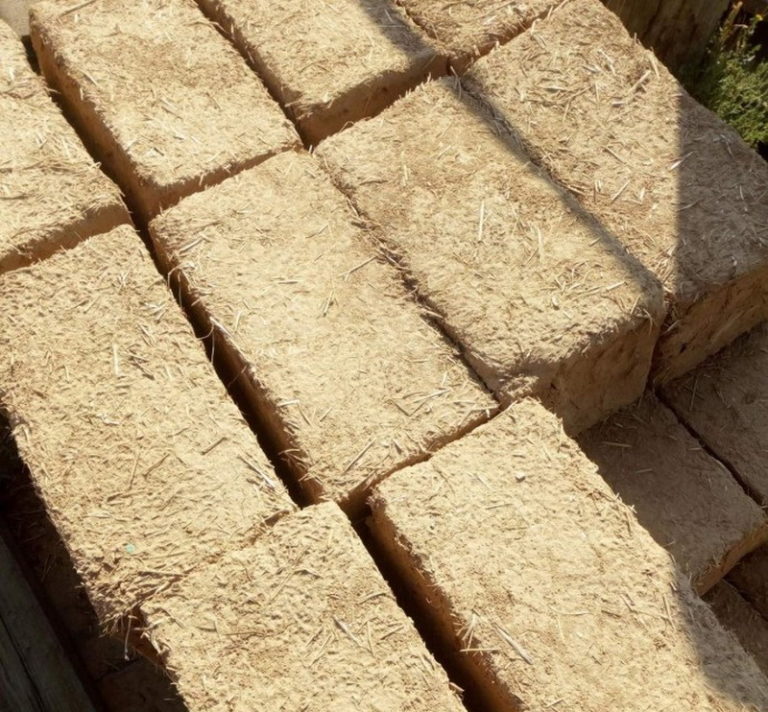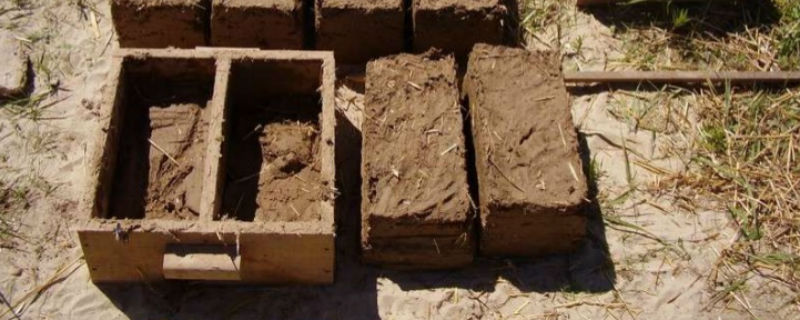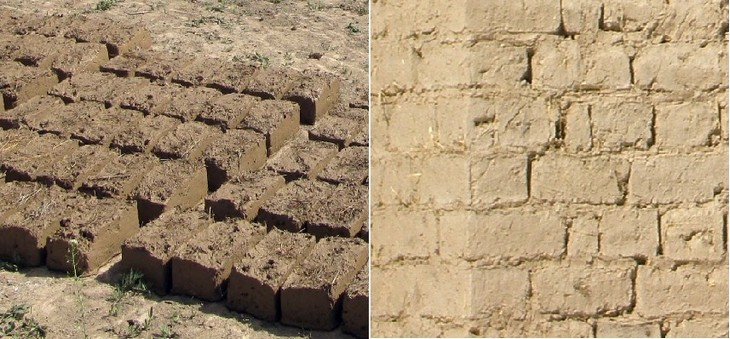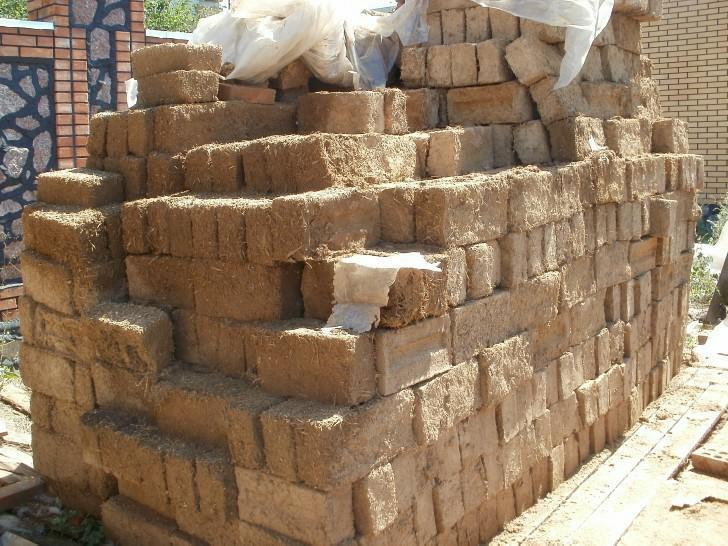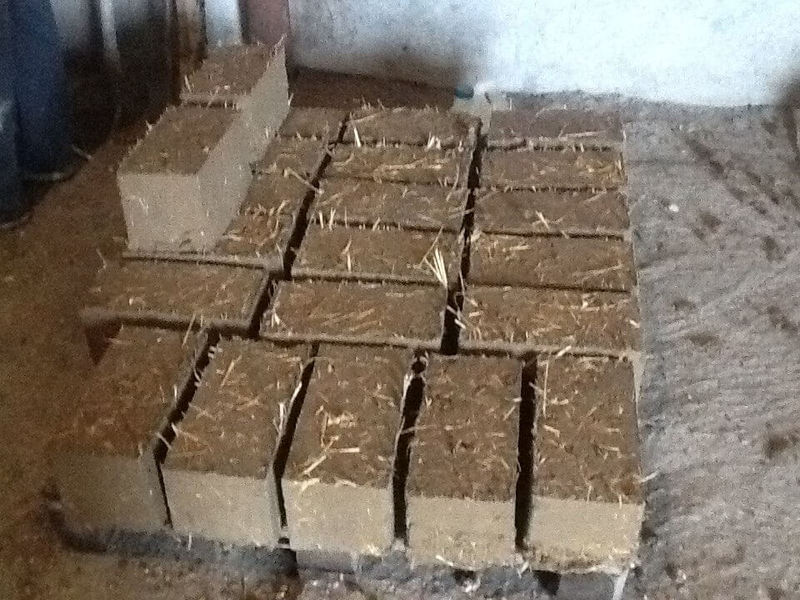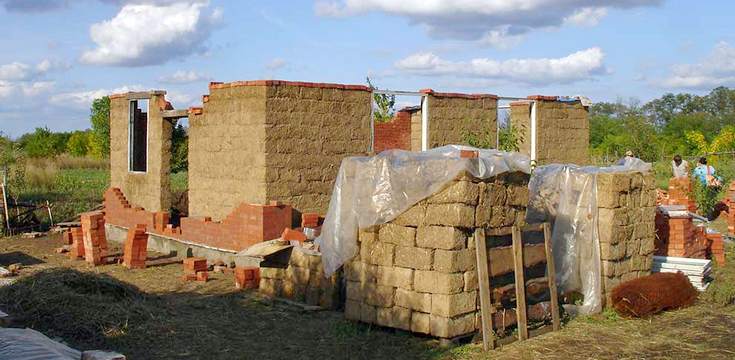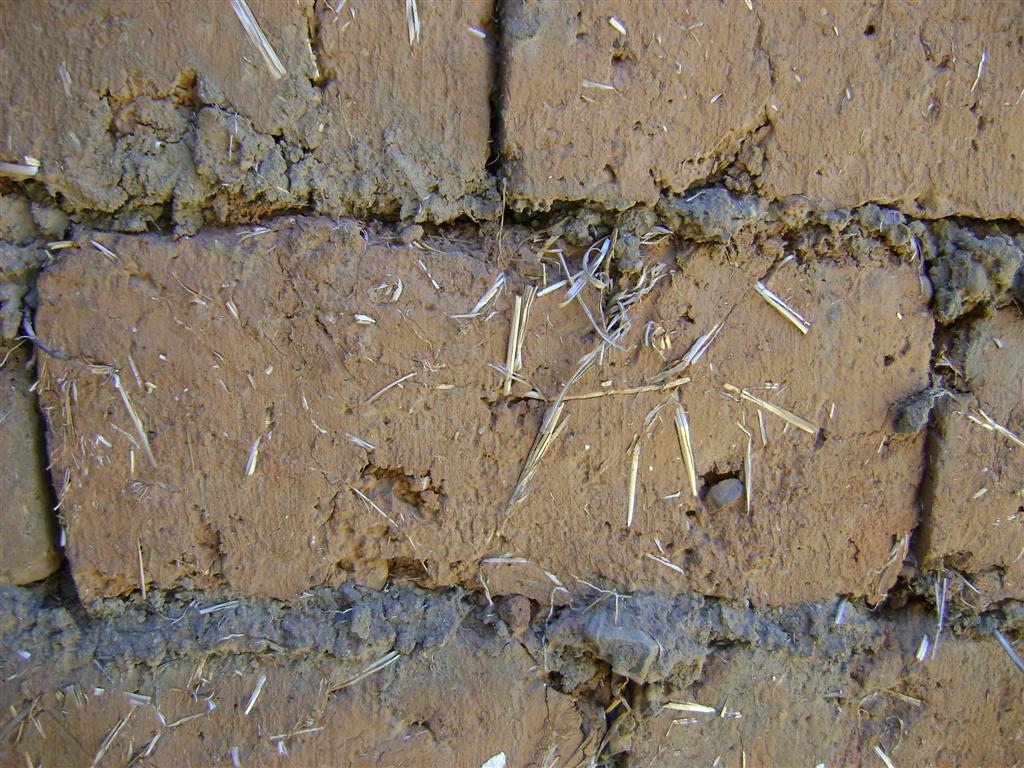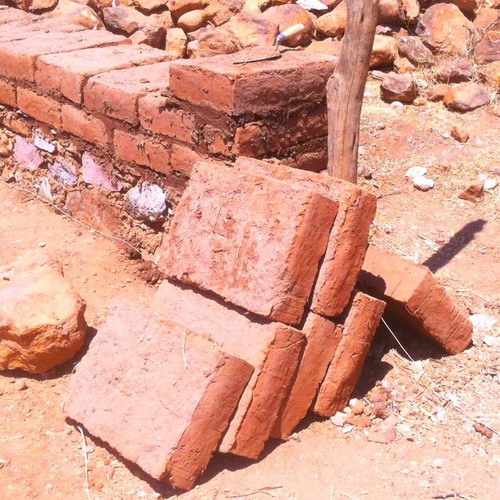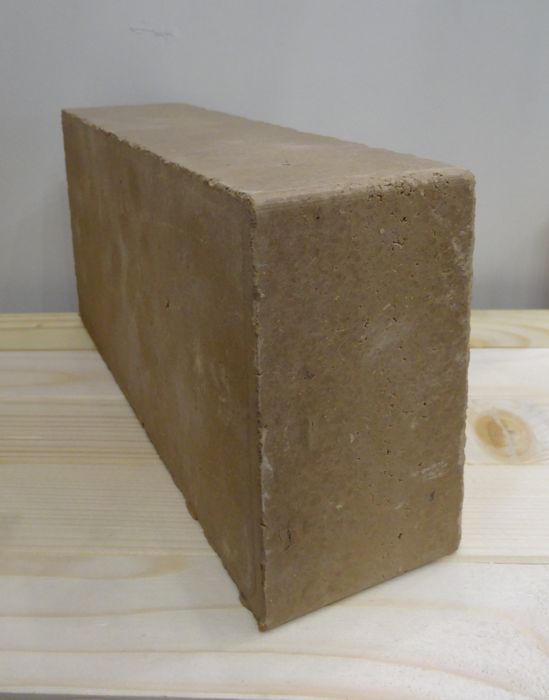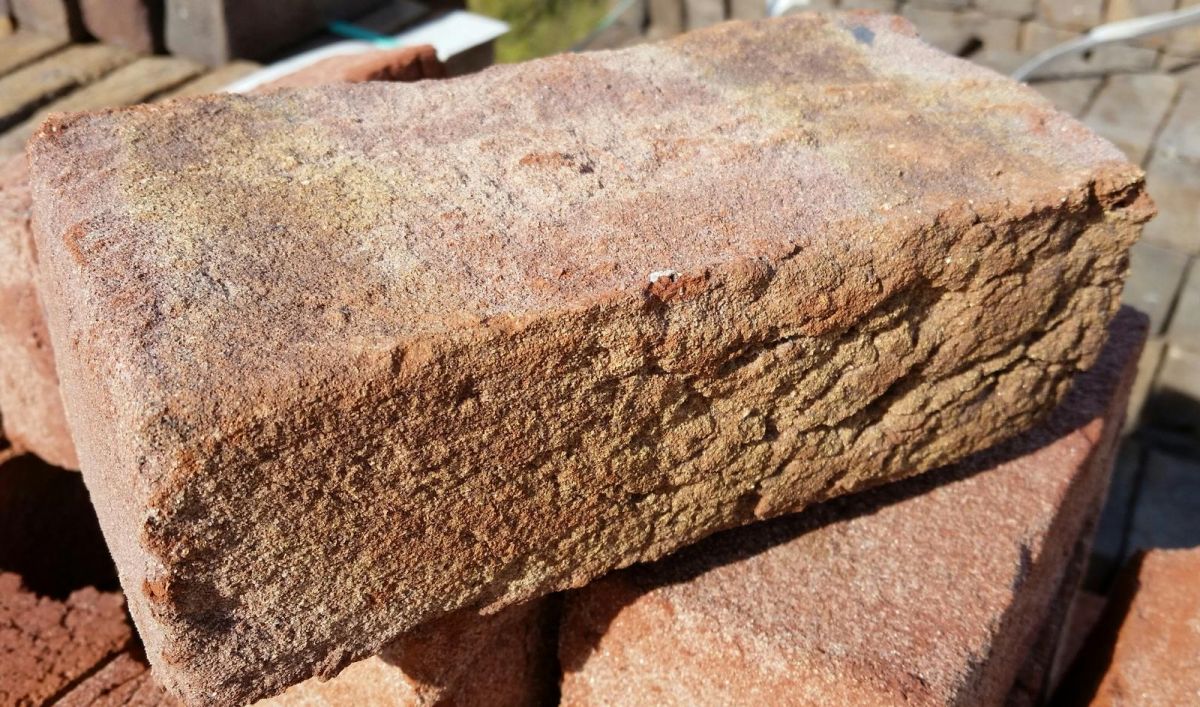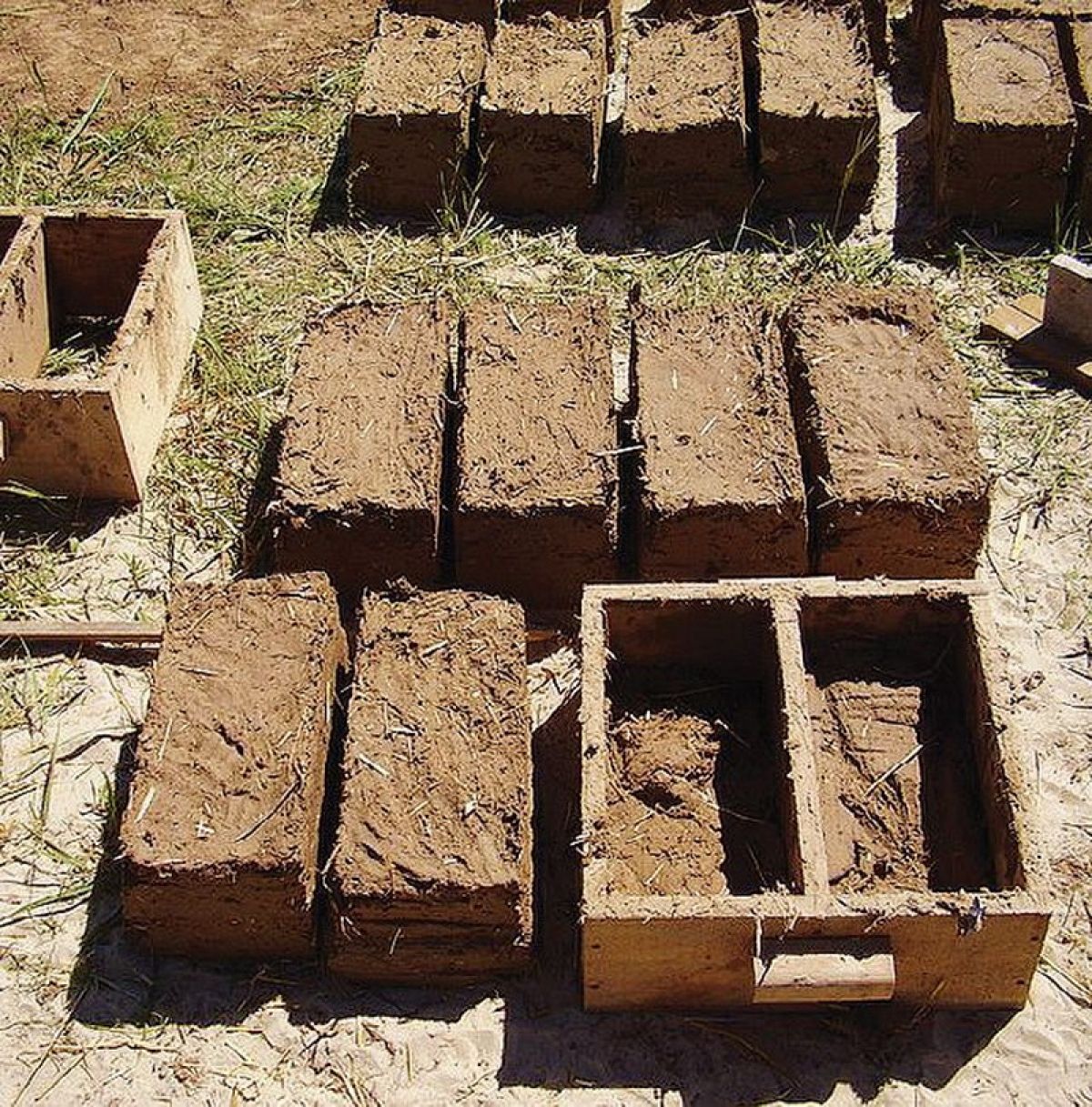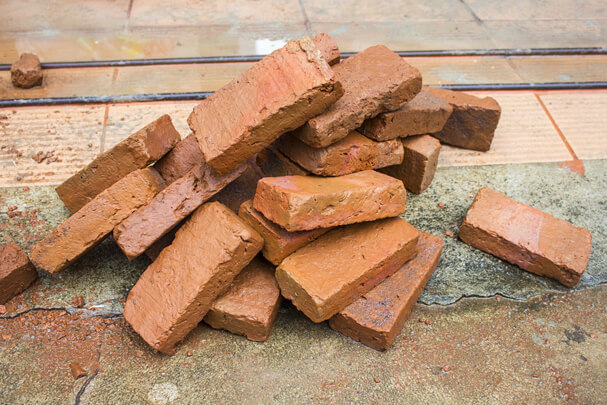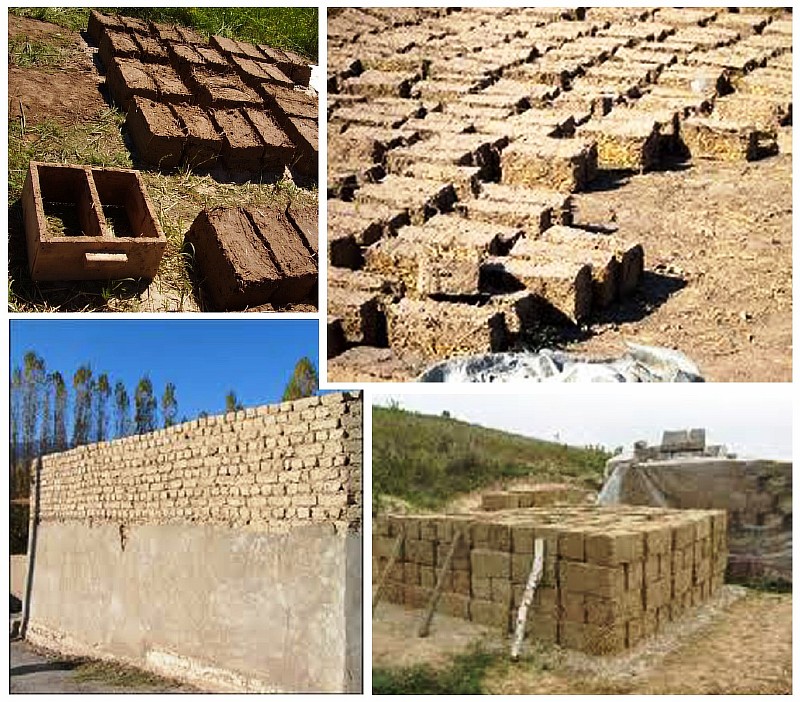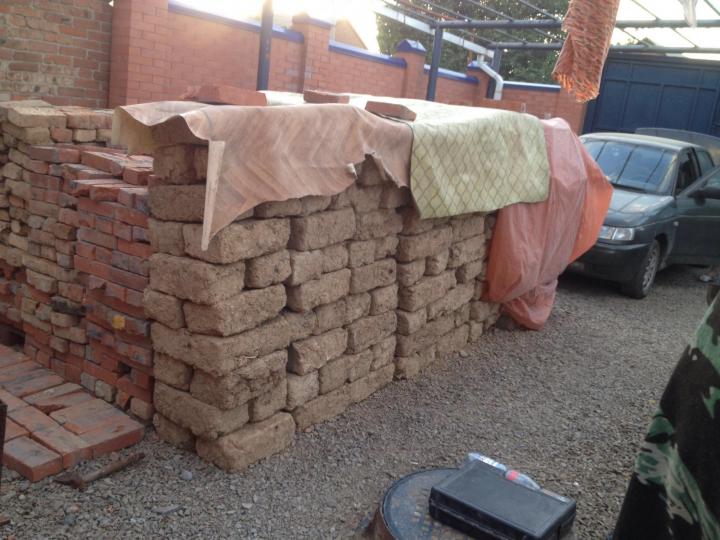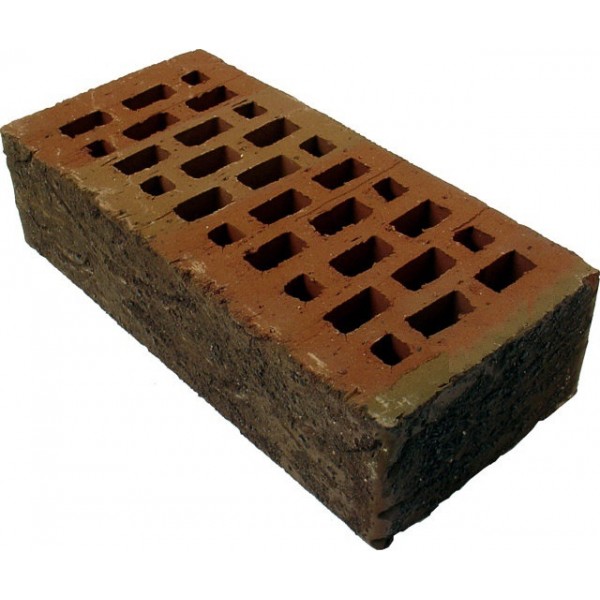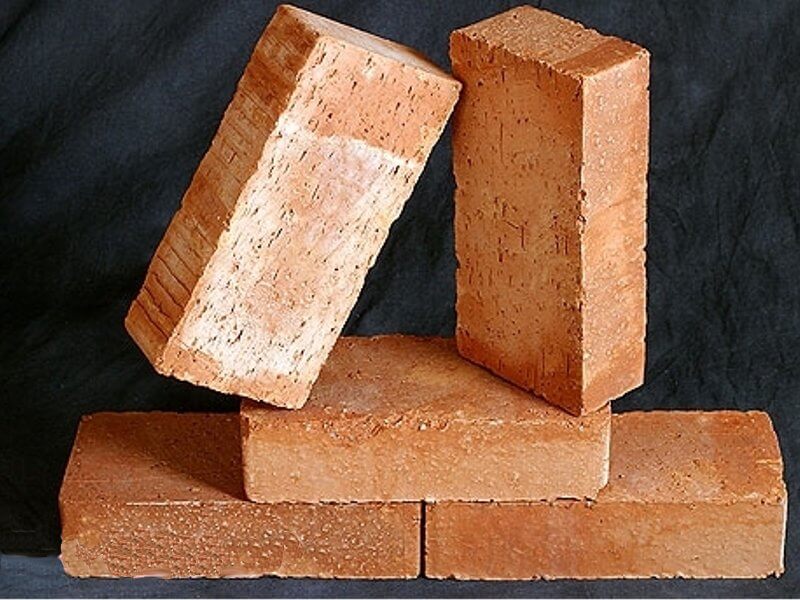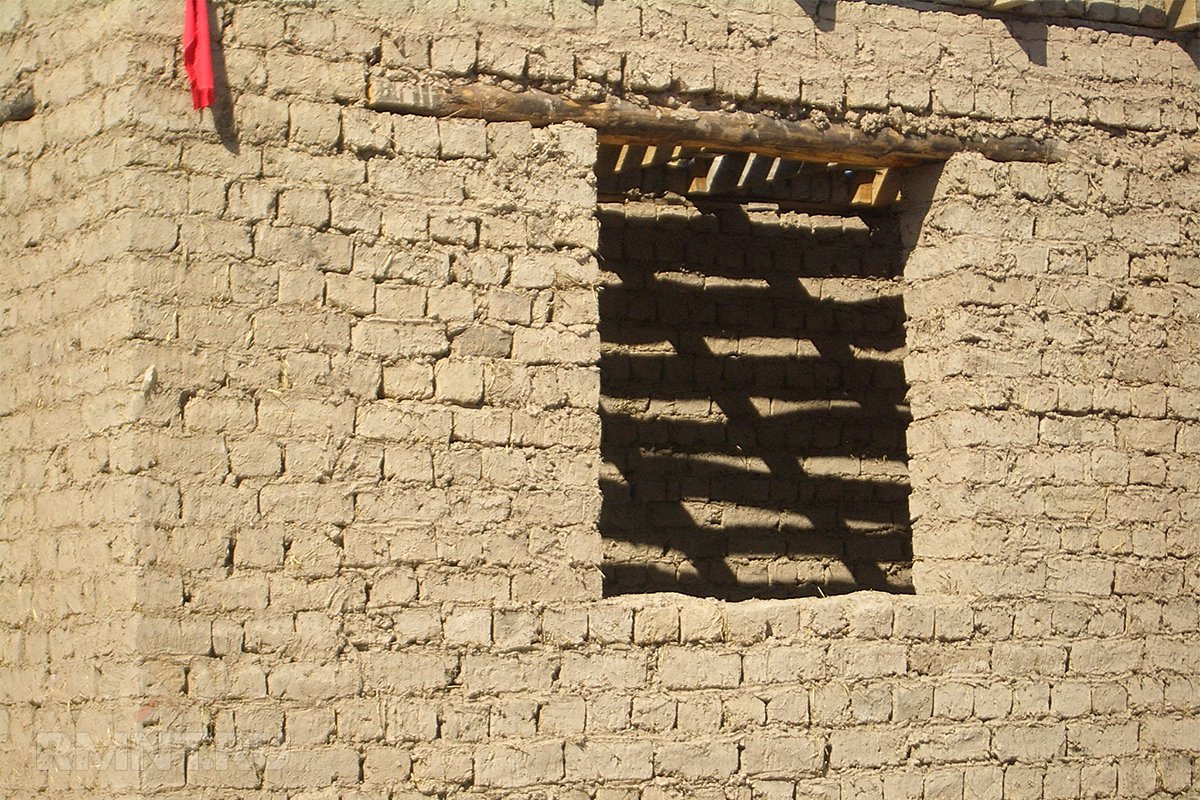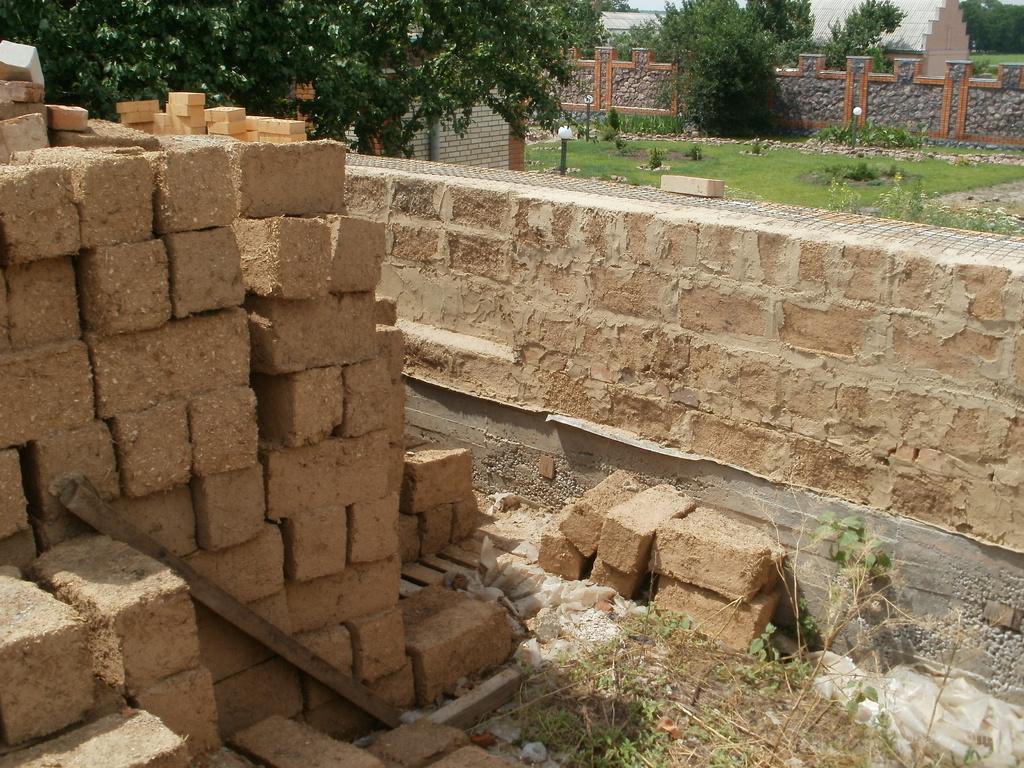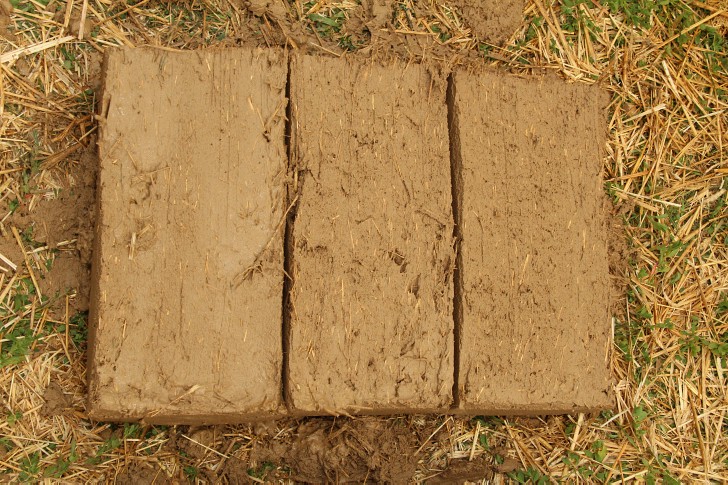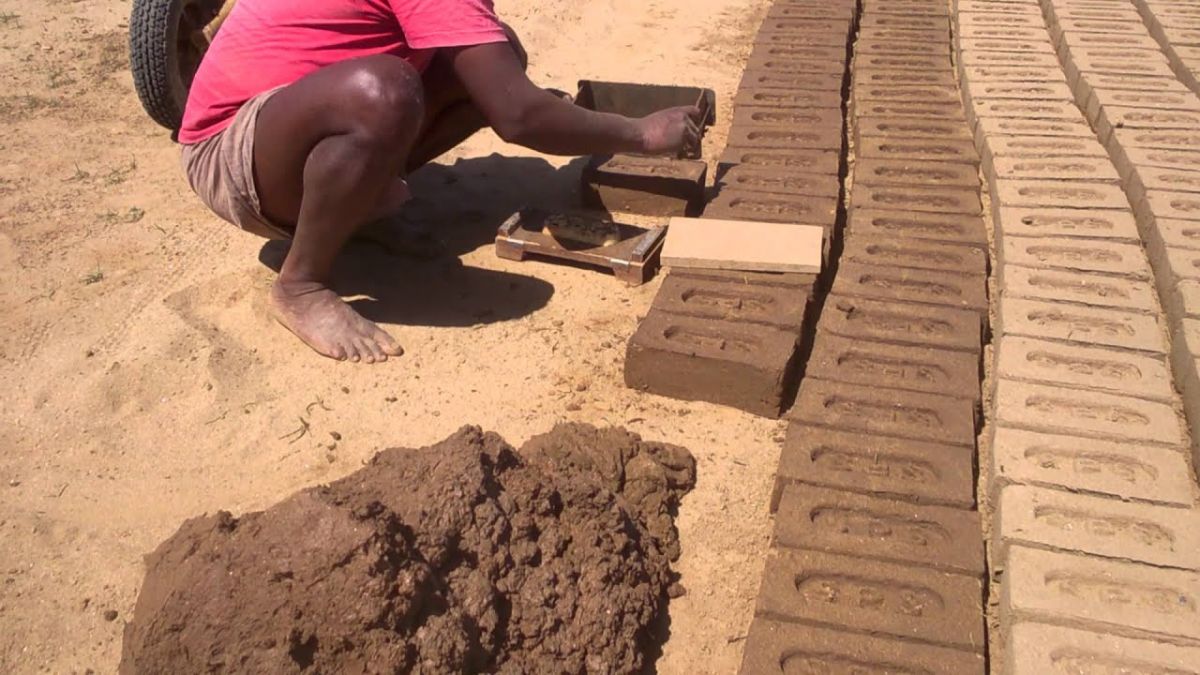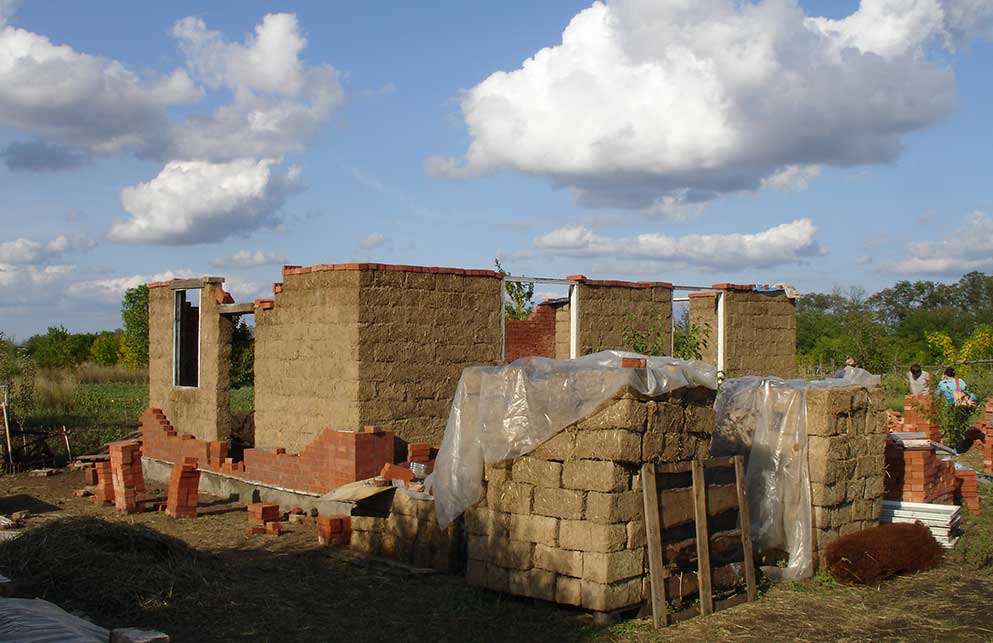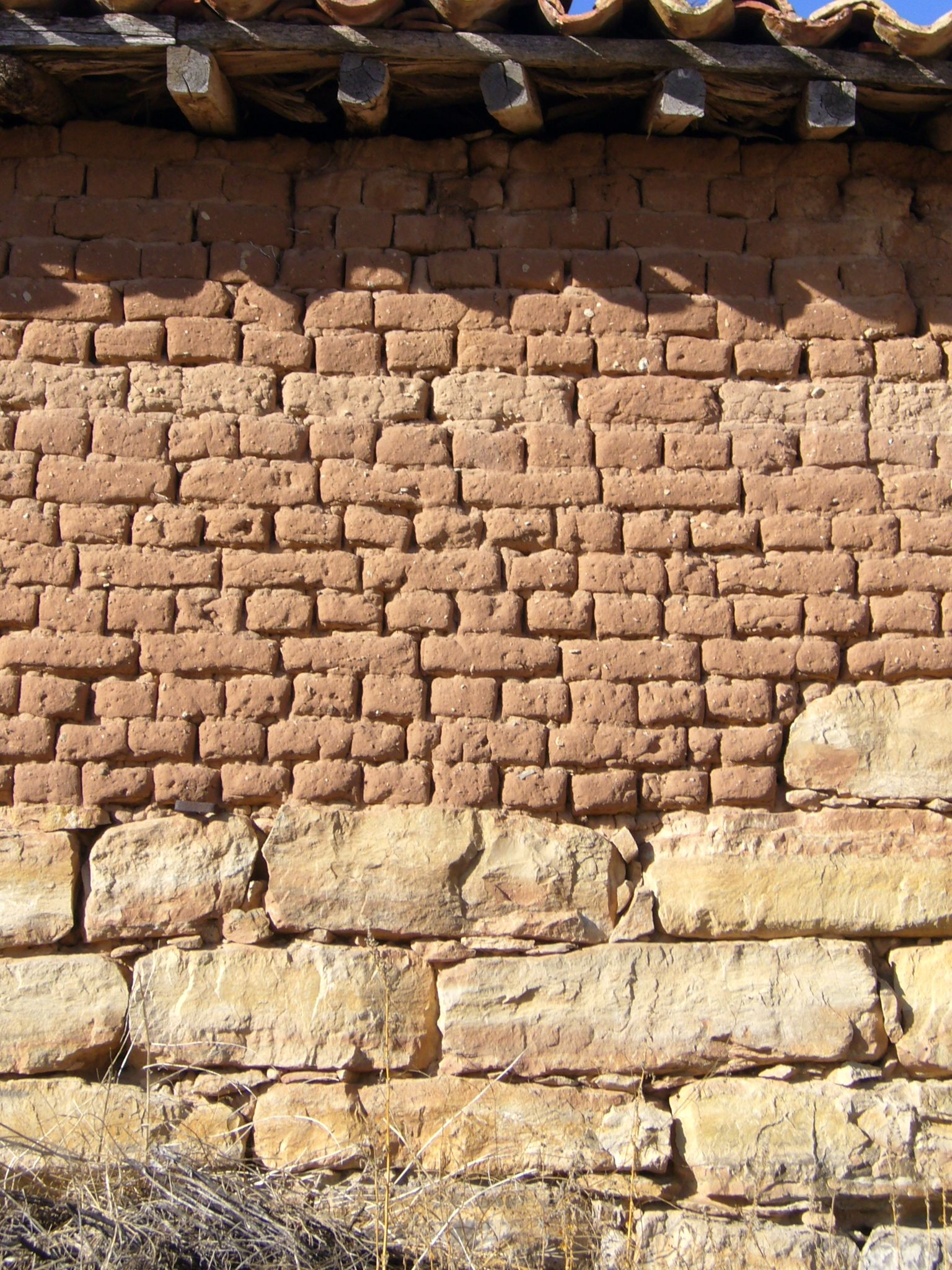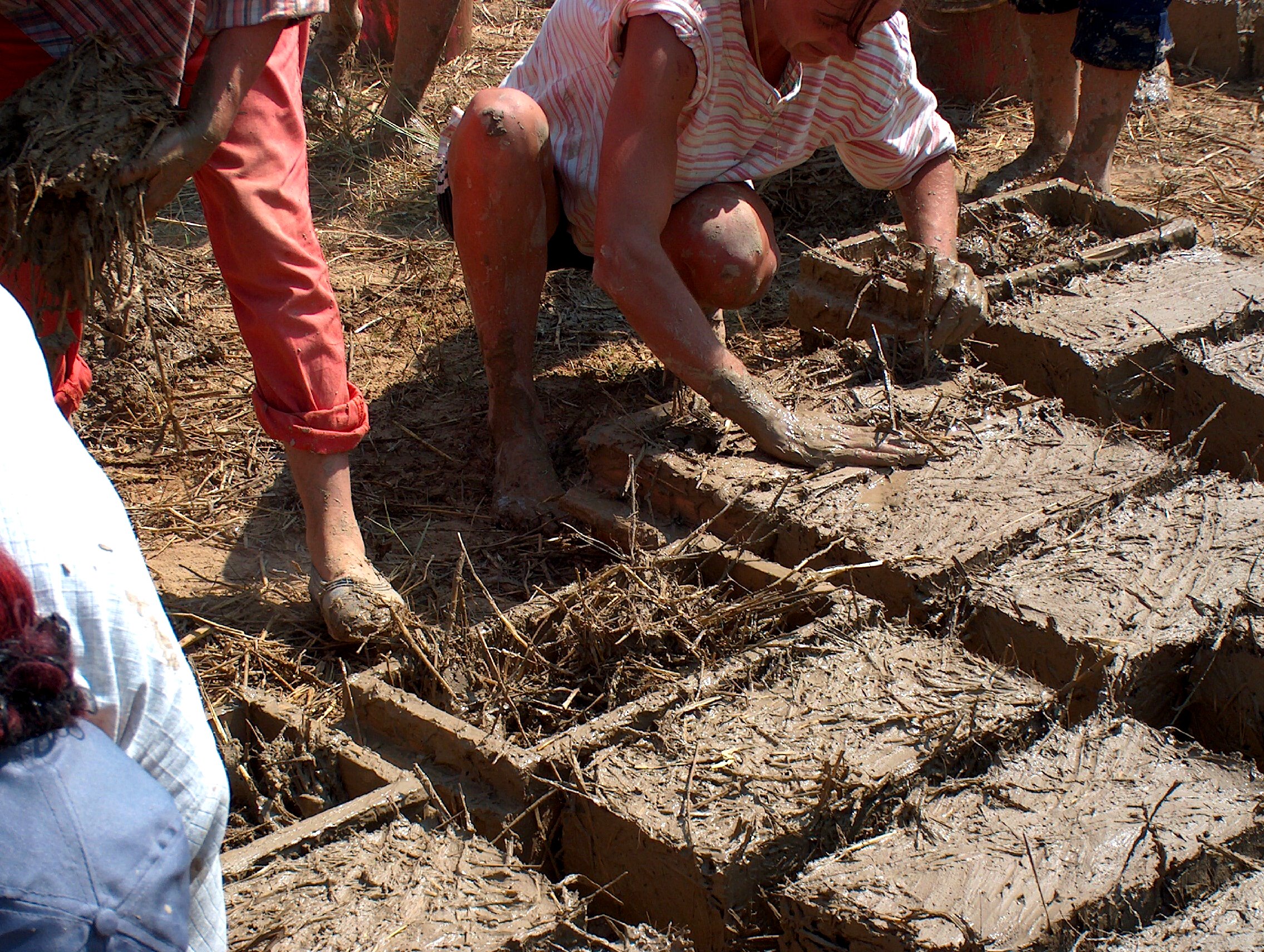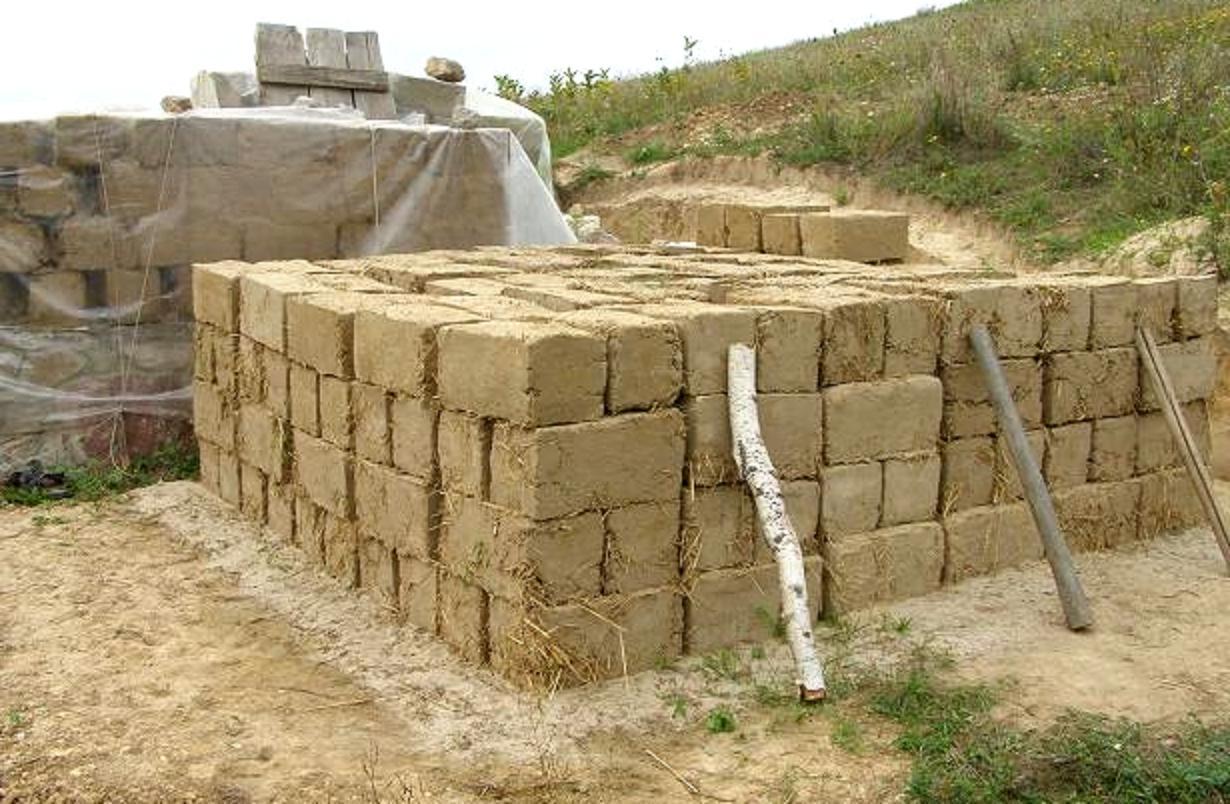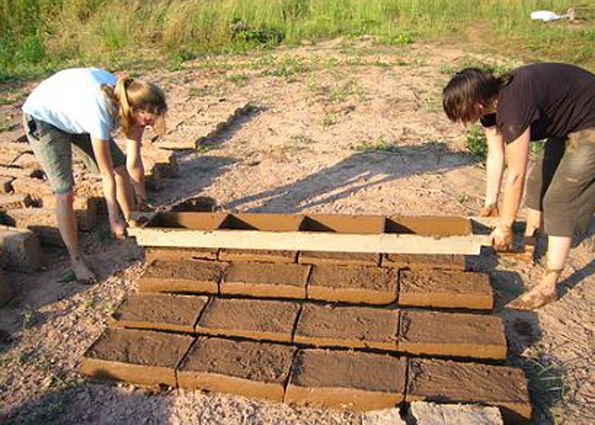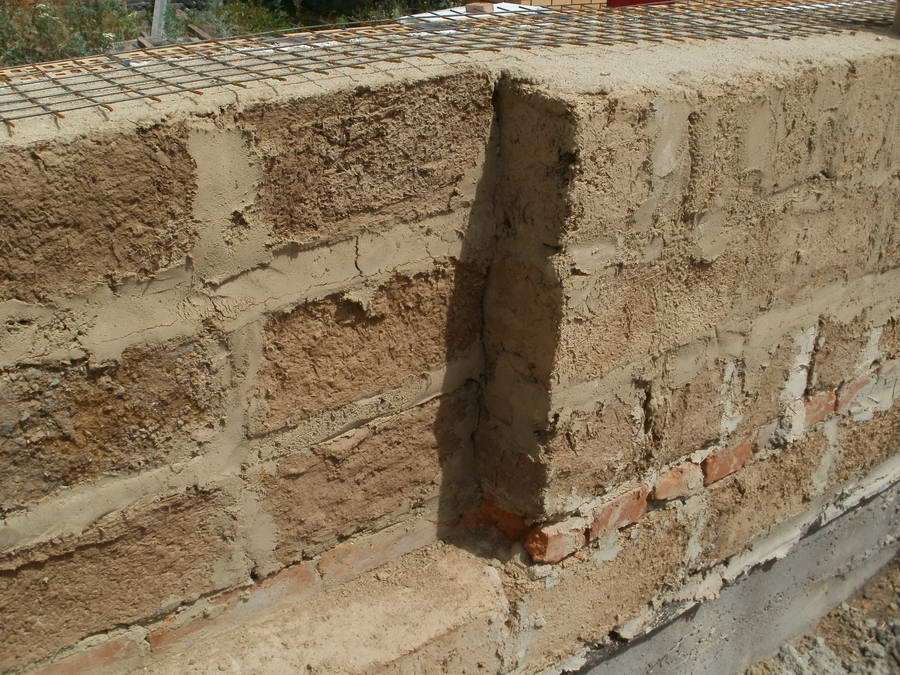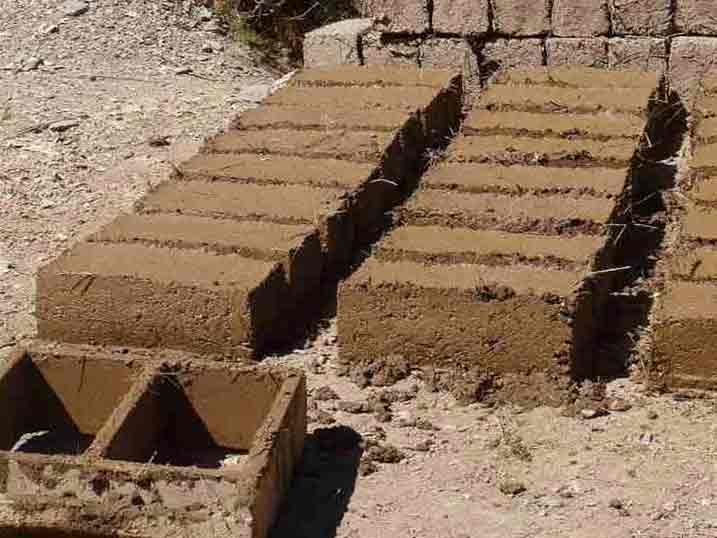Pros and cons of adobe construction
Clay and straw bricks provide the following indisputable advantages to buildings made of it:
- Cheapness (obtaining raw materials for the manufacture of blocks - clay and water mixed with sand and straw - is not a problem: clay is often taken from the very pit that is being prepared for construction, the rest of the components are also usually within walking distance).
- Strength.
- Absolute environmental friendliness.
- High soundproof and heat-saving characteristics.
- Resistance to fire (with a moderate content of cellulose in the building material).
- The ability of walls to absorb excess moisture in rooms.
However, such a brick is not without some disadvantages:
- low frost and moisture resistance (in an appropriate climate, external plastering of the walls or covering them with facing bricks is required);
- unsuitability for use without chemical additives in winter construction conditions;
- in a temperate climatic zone - a long period of drying of buildings and their gaining strength;
- is a favorable environment for the life of rodents, fungi and insects.
Thus, it is advisable to use adobe only in a sufficiently warm and dry climate. As for Russia, SNiP II-22-81 “Stone and reinforced masonry structures”, approved in 2003, clearly states that adobe bricks are permissible for use in wall structures only for those buildings whose expected service life does not exceed 25 years.
Composition of clay-straw bricks
Despite this one-sided name, reflecting only the presence of straw in the material, in reality, traditional adobe consists of several components:
- water serving as a solvent;
- medium fat clay as the base of the mixture;
- acting as a filler for wheat, rye or barley straw;
- river sand.
In the case of the forced use of clay with not very good characteristics, prone to cracking during drying, peat soil or black soil is added to it, as a result of which a so-called earthen brick is obtained.
Instead of straw, which provides an increase in the tensile strength of the building material, sometimes a fire (lignified fragments of the stems of spinning plants), chaff (husk remaining after threshing grain), wood chips and other materials are used. Sand, which reduces shrinkage during drying, can be replaced with fine gravel, crushed stone or expanded clay.
Modern builders often make an adobe composition with an admixture of lime or cement, which increase the resistance of the brick to moisture and accelerate hardening. An increase in the plasticity of adobe is achieved by adding to its composition liquid glass, bone glue, casein, molasses, slurry (its specific smell disappears completely after the clay dries) or starch.
Saman has a porous structure and high vapor permeability, which allows you to create a comfortable microclimate in the house.
However, adobe blocks do not require the mandatory inclusion of chemical components in them. Natural clay already has qualities that provide adobe structures with all the necessary characteristics. Chemicals are usually introduced in cases when it is necessary to speed up the process of bricks hardening, to ensure the highest resistance of the structure to the effects of microorganisms and rodents, and to increase the fire resistance of the material.
Adobe, made from high-quality raw materials with strict adherence to technology, is distinguished by its durability, the ability not to soak in water for at least one day and not to break when dropped from a height of 2 meters. You can even cut it with an ax or hew with a pickaxe, while the block will not crumble or fall apart.
Special brick: made of clay and straw
Today, as well as many centuries ago, brick plays a leading role in monumental construction, the most common types of which are ceramic and silicate. However, there is another type of this popular building material, which is practically not used in central and northern Russia and, as a result, is little known.
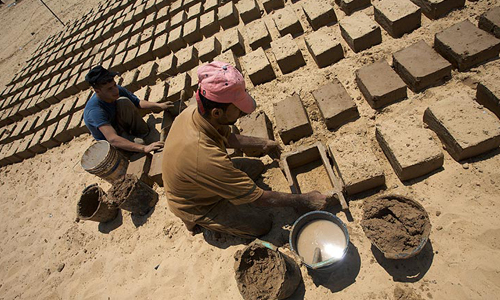
Adobe bricks are used in the construction of low-rise buildings and temporary buildings; housing made of this material is suitable only in the southern regions.
It is made from unbaked clay, to which a certain amount of chopped dry straw is added (most often ¼ of the total volume). This mass is thoroughly mixed, placed in rectangular forms of wood and dried in the fresh air for 7-10 days.
Most often, such a mud brick is called adobe, which in translation from Turkic means “straw”.
The Arabs, who have also long used this composite material in construction, called it at-tob, and the Spaniards later renamed it adob by consonance (in Russian, the term adoba is used as a variant). Nowadays, clay-straw building mixture is also called clay concrete or clay-fiber concrete.
The walls of adobe bricks are often folded no more than 2 floors high and plaster is applied, from clay or lime-clay mortar.
The technology for making adobe was invented in ancient times (about 4 millennium BC) in Egypt, from where it was borrowed by the Persians. Blocks of clay mixed with straw were widely used for the construction of dwellings and fences in treeless areas with a predominantly dry climate. Today they are used in low-rise construction in Asian countries, southern regions of Ukraine and Moldova. In the Russian Federation, adobe houses can be found mainly in rural settlements of the North Caucasus.
The adobe type bricks are variable in size (they depend on local conditions):
- a large block has a ratio of 40 × 19 × 13 cm;
- medium - 30 × 17 × 13 cm;
- small - 30 × 14 × 10 cm.
Characteristics of adobe
Saman is called a brick made of clay and straw with the addition of water, but exact proportions, as well as a complete set of components, do not exist - the composition of an artificial stone can differ significantly depending on what characteristics are required of it.
The main ingredient of any adobe was and is clay, preference is given to varieties with medium fat content. The viscosity of the mass can be different, therefore, if necessary, add a certain amount of water in order to make it easier to mix the composition. Traditionally, a filler was also used, which increased the strength of the dried clay, holding it together, and somewhat improved thermal conductivity.
Of course, the ingredients described above were all limited in the old days, but today, in the age of developed technologies, the composition of adobe can contain various additives that significantly improve certain qualities of such a brick:
- crushed stone, sand or expanded clay crumbs in half with clay allow the drying building material to avoid strong shrinkage, while maintaining the specified dimensions and shape;
- casein and bone glue, as well as archaic slurry or modern liquid glass can be used instead of water to give uncured adobe blocks any desired shape without spreading;
- lime and cement are known for their ability to quickly release moisture into the environment, therefore they are added to the recipe so that the bricks dry faster and are moisture resistant;
- fibrous cellulose, chopped straw, wood chips or the same manure allow adobe to be also relatively elastic, which increases the resistance of the material to temperature extremes and compression or stretching.
The exact date of the discovery of adobe is unknown, but scientists say that houses from it were built six thousand years ago.At that time, this was almost the only way out for the inhabitants of the steppe and desert zones, where even more traditional wood or natural stone were practically not found. As it happens in any era and in any state, building a house was also associated with huge costs, because the poor population had no choice but to come up with a way of building from what lies underfoot and no one really needs it. Ancient Egypt is considered the birthplace of the first adobe, and from there such material spread to many regions with the described climate conditions.
Modern adobe bricks can have different characteristics, which strongly depend on the components included in its composition and their proportions, but on average, you should get something like this:
- density comparable to ordinary brick - at the level of 1500-1900 kg per cubic meter;
- thermal conductivity depends, first of all, on the amount of straw used (the more there is, the better the walls retain heat), but in general adobe is twice as good as a simple brick in this indicator - 0.1-0.4 W / (m * deg);
- in terms of resistance to compression, adobe blocks are very reminiscent of a modern foam block - in both cases, this indicator ranges from 10-50 kg per square centimeter.
The exact characteristics of adobe and products made from it depend on the composition of the mixture and the percentage of light fillers in it:
- heavy adobe has a density of the order of 1500–1800 kg / m3, that is, it practically coincides with the density of building bricks;
- the thermal conductivity coefficient is two times lower than that of building bricks - about 0.1–0.4 W / m · ° С. The more straw is contained in heavy adobe and the higher its density, the lower its thermal conductivity;
- compressive strength is about 10-50 kg / cm2, this strength range is close to the characteristics of foam and aerated concrete.
Advantages of adobe construction:
- the cheapest construction material, since the raw materials for its production - clay and water - are found everywhere and in abundance;
- absolute environmental friendliness of adobe buildings;
- low heat transfer and high sound insulation of walls;
- fire resistance;
- the ability to absorb excess moisture in rooms.
Minuses:
- poor resistance to moisture, especially at low temperatures - external plastering or overlapping of walls with facing bricks is required;
- the impossibility of conducting construction work in winter conditions;
- buildings erected in a temperate climatic zone dry for a long time and gain strength;
- adobe walls create favorable conditions for rodents, insects and fungi to live in them.
A house made of adobe takes longer to build than houses made of traditional materials - it takes longer for the walls to set their strength characteristics. However, the final estimate of construction costs will be at least twice as low as for a building made of building bricks of a similar area.
The nuances of making adobe
Clay is called a thick mass made of greasy clay that does not have impurities. The whole technology of its preparation consists in diluting the clay with water, and carefully tamping it. As the water evaporates, the solution thickens.
- Readiness is checked in the old-fashioned way: they put a clay block on a stick, and if it only slightly bends and no longer deforms, it means that the adobe has turned out to be of high quality. It is from it that adobe bricks (clay concrete) are made.
- It is an excellent material for the construction of stoves, but for the construction of houses, people have long preferred to make stones filled with straw, wool, sawdust. The reason is simple: the walls are warmer.
- In rural areas located in the southern latitudes, clay-straw stone (adobe) is still quite popular today. Not only sheds, chicken coops and pigsties are built from it, but also residential buildings.
Two-storey adobe house
Pasting the outer walls with adobe
The owner is doubly pleased with the fact that such a house can look very interesting, and even with a claim to originality, and the price that will have to be paid in this case will be minimal.
Features of clay stone
Clay-concrete molded stone - like adobe, by the way, can only be dried, and can also be fired. In the first case, it will be a raw brick, and in the second, a full-fledged brick.
Subject to standard dimensions, the weight of hand-molded clay bricks does not differ much from the weight of ordinary solid bricks, and varies in the range of 3.25-3.45 kg.
Light clay fired brick: hand molded
Despite the fact that the geometry of the bar does not always correspond to the existing standard, and has some deviations, in general it has a good appearance, and can be used not only for the construction of stoves, but also for the front masonry of semi-antique facades.
Clay brick red
As for adobe, after firing it turns out to be porous, which means that its thermal conductivity indicators improve. The pores are formed due to the burning out of the straw during the firing process.
In this case, the stone ceases to be susceptible to moisture. In this case, it can be used for private construction, even in areas with a damp climate.
Adobe wall with brick cladding
If the adobe walls are overlaid with facing bricks, which we see in the example above, the house will turn out not only warm, but will also have a quite decent appearance. Saman is an excellent alternative to aerated concrete blocks, which are many times more expensive and are not available in every locality.
Plastering the furnace with clay
Laying bricks on clay is also preferable in the construction of stoves, which is no longer done for the sake of economy. At high temperatures, a clay mortar forms a monolith with a brick, which ideally retains heat. That is why the ovens are often completely coated with clay on top.
To make the adobe of high quality
To obtain the correct adobe mass, the clay used for kneading must be homogeneous. It should not contain even an insignificant gravel content. When heated, it expands more, and will simply destroy the stone from the inside.
So:
- To obtain a good quality red clay brick, or a mortar for laying a stove, there should also be no lime inclusions in it.
- At high temperatures, lime turns into a boil, and when water gets in, it provokes the formation of blisters and cracks in the bricks.
- Therefore, when pouring clay with water, it is first probed with hands, removing all large inclusions. If these are lumps of lime larger than 3 mm, their percentage must be determined.
- To do this, weigh the entire portion of the soaked clay, and separately - lime lumps. It turned out that there is more than 0.5 kg of lime per 5 kg of clay? It is definitely not suitable for oven bricks!
Knead the clay with your feet
- In general, the best assistant in the manufacture of adobe is time. If you seriously set out to make a brick yourself, keep in mind that the preparation of clay should begin in a year, or even better in two.
- It is spread in the garden in a layer of 10-12 cm, and left directly in the open air. Repeated freeze and thaw cycles will destroy all impurities, and only quality clay will remain.
- Its uniform saturation with water is an extremely important nuance. Therefore, before proceeding to kneading the solution, it is simply poured over, and given several hours for swelling.
Then the mass is stirred with a shovel, processed with a rammer, and only then they begin to knead. At the end of this process, the tamped clay is covered with a wet cloth and left to lie down for another 10-12 hours - only after that you can begin to mold the adobe brick.
Composition
This material can be made according to various recipes, but mainly pure clay is used for its production and, if necessary, various components are added to its composition, which improve the quality and characteristics of the finished product. Among these components are the following:
- shavings (increases the strength of the stone);
- straw (improves plasticity).
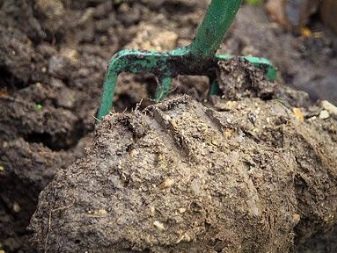
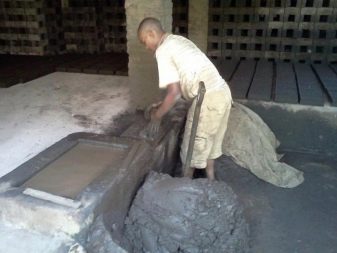
When preparing raw materials for production, it is important to correctly identify and select the desired grade of clay. It may differ in its characteristics depending on the location
It is usually located in the ground at a depth of 1 m. Extraction can be carried out on your territory, which will make the production of building material even cheaper. Clay can also be bought in quarries.
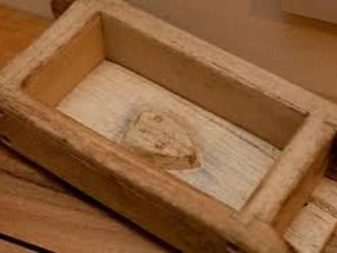
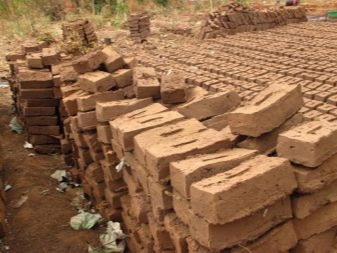
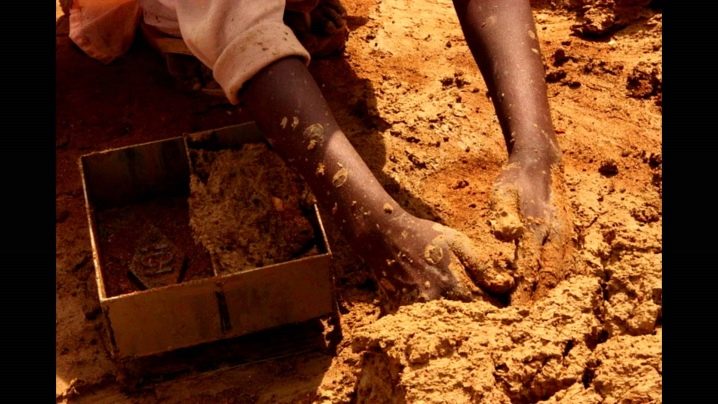
Composition of clay-straw bricks
Despite this one-sided name, reflecting only the presence of straw in the material, in reality, traditional adobe consists of several components:
- water serving as a solvent;
- medium fat clay as the base of the mixture;
- acting as a filler for wheat, rye or barley straw;
- river sand.
In the case of the forced use of clay with not very good characteristics, prone to cracking during drying, peat soil or black soil is added to it, as a result of which a so-called earthen brick is obtained.
Instead of straw, which provides an increase in the tensile strength of the building material, sometimes a fire (lignified fragments of the stems of spinning plants), chaff (husk remaining after threshing grain), wood chips and other materials are used. Sand, which reduces shrinkage during drying, can be replaced with fine gravel, crushed stone or expanded clay.
Modern builders often make an adobe composition with an admixture of lime or cement, which increase the resistance of the brick to moisture and accelerate hardening. An increase in the plasticity of adobe is achieved by adding to its composition liquid glass, bone glue, casein, molasses, slurry (its specific smell disappears completely after the clay dries) or starch.
Saman has a porous structure and high vapor permeability, which allows you to create a comfortable microclimate in the house.
However, adobe blocks do not require the mandatory inclusion of chemical components in them. Natural clay already has qualities that provide adobe structures with all the necessary characteristics. Chemicals are usually introduced in cases when it is necessary to speed up the process of bricks hardening, to ensure the highest resistance of the structure to the effects of microorganisms and rodents, and to increase the fire resistance of the material.
Adobe, made from high-quality raw materials with strict adherence to technology, is distinguished by its durability, the ability not to soak in water for at least one day and not to break when dropped from a height of 2 meters. You can even cut it with an ax or hew with a pickaxe, while the block will not crumble or fall apart.
Production
Preparation of raw materials
After cleaning from impurities, organic fillers (sawdust, straw, manure, etc.) are added to the clay. The components are mixed together with the addition of a small amount of water to make the composition viscous. Mixing is done in concrete mixers. When the mass becomes homogeneous, it is laid out in molds.
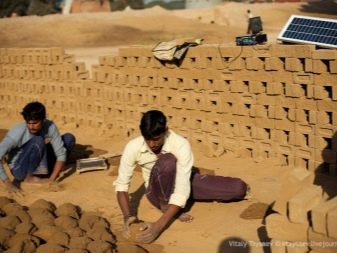
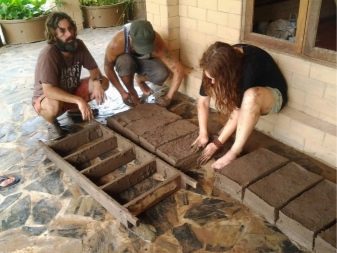
Form creation
For the manufacture of bricks with chopped straw or shavings, various shapes can be used, which will be optimal in each case. But if it is necessary that the products do not differ in appearance from the store ones, then it is recommended to adhere to the standard parameters in the manufacture of forms - 25x12x6.5 cm.
To make the molds, you need to prepare the boards from which the side walls will be made, as well as plywood for the construction of the lid and bottom. Forms can be made single or with a different number of cells. For the manufacturing process to be continuous, it is necessary to prepare a sufficient number of forms.Also, when making a mold, it is necessary to take into account that the brick in it will dry out, and therefore, initially it should be about 10% more than the estimated volume, so that when drying the brick turns out to be of standard sizes.
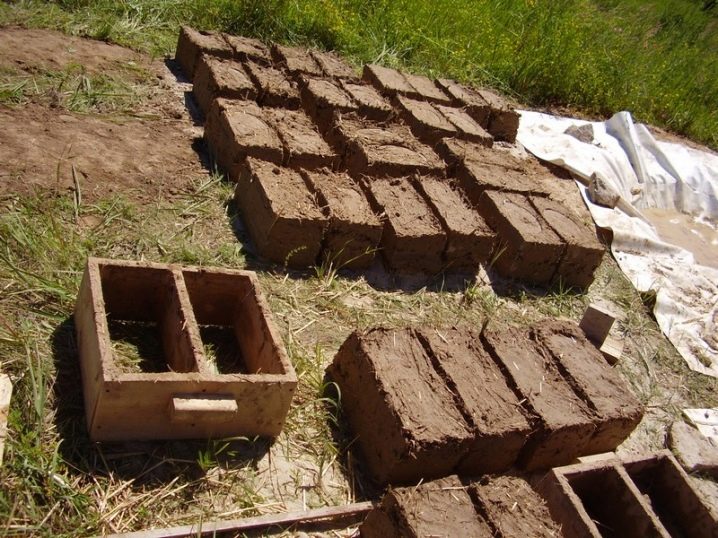
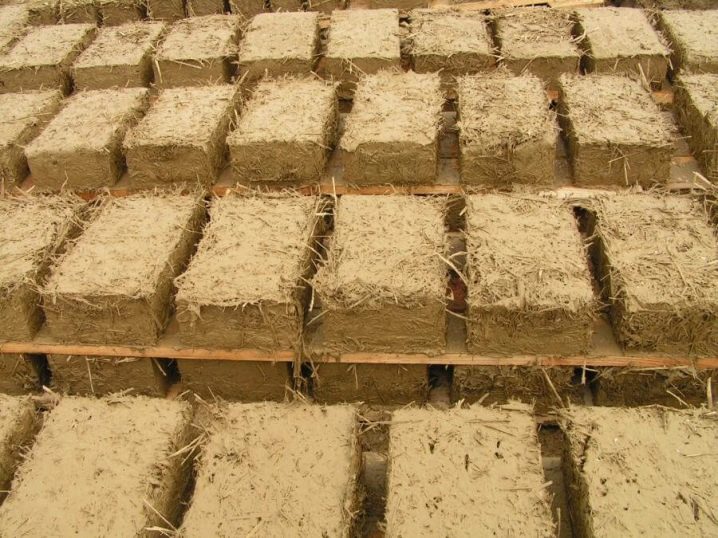
The main process
In handicraft production, a press is not used, therefore it is important to correctly develop the technology for forming raw bricks and filling out forms. This will simplify and speed up your work.
Pre-form must be moistened with water and sprinkled with cement or clay. You can also use chalk or sand for this purpose. These compounds will help the brick to fall out of shape more easily.
In order for the bricks to be obtained with even corners, it is necessary to tightly fill the molds with raw materials, and then tamp the clay. To do this, use a shovel or trowel. Excess clay is removed, after which the mold is closed and shaken.
After that, it is necessary to remove the form, and the workpiece must remain in place for a while, until it dries, so that it does not get damaged when moving. It is better to install the finished bricks on a flat area, sprinkled with sand on top so that the material does not stick to the ground. The distance between individual bricks should be at least 3 cm so that they dry well.
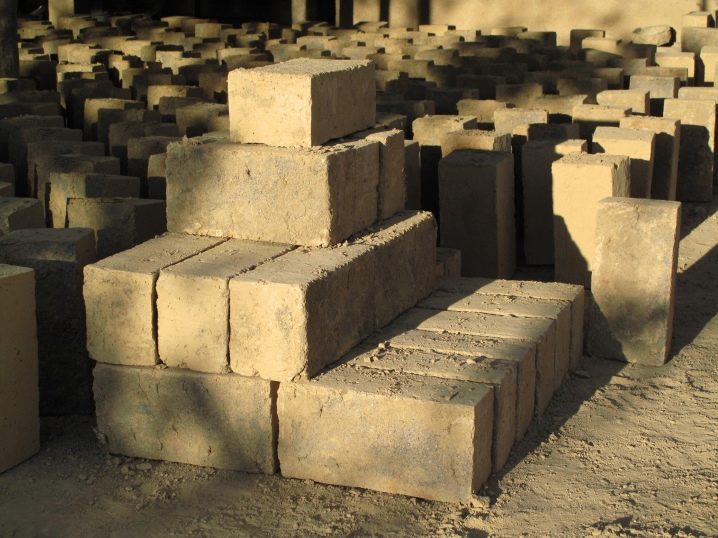
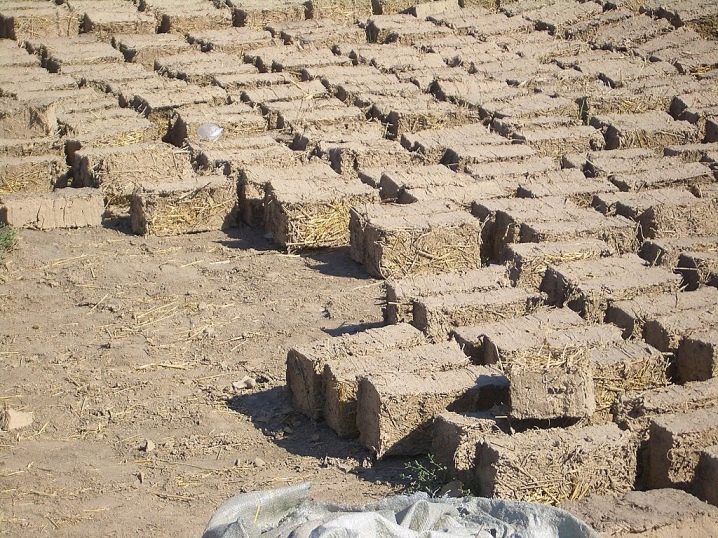
Drying and storage
The strength of the raw brick depends primarily on the correct drying of the product. Its appearance also depends on it. If the moisture evaporates unevenly, this will cause a violation of the geometry of the bricks, therefore, it is necessary to organize a long drying and this should be done under a canopy.
After the products have gained strength, they can be stacked, leaving small gaps between the rows for blowing. The height of such stacks is no more than 1 m. Each row is woken up with sand.
Drying times are different and depend on the following factors:
- drying mode;
- weather;
- quality of raw materials.
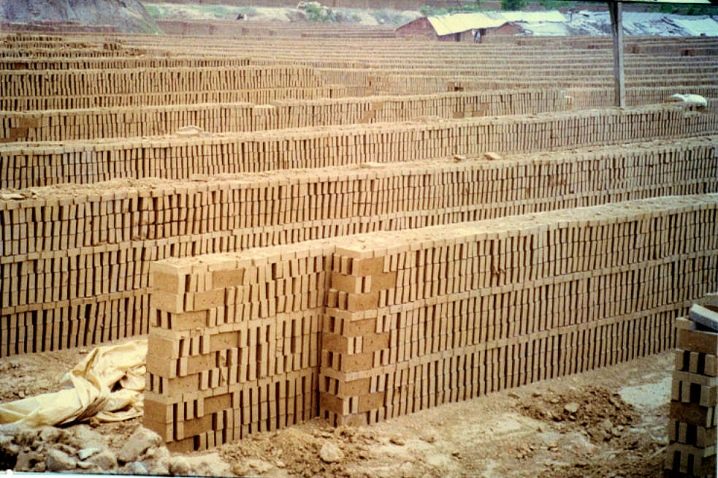
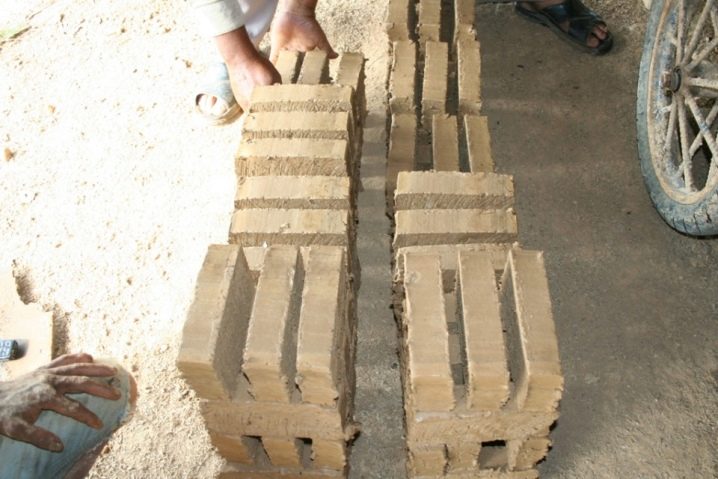
Pros and cons of adobe construction
Clay and straw bricks provide the following indisputable advantages to buildings made of it:
- Cheapness (obtaining raw materials for the manufacture of blocks - clay and water mixed with sand and straw - is not a problem: clay is often taken from the very pit that is being prepared for construction, the rest of the components are also usually within walking distance).
- Strength.
- Absolute environmental friendliness.
- High soundproof and heat-saving characteristics.
- Resistance to fire (with a moderate content of cellulose in the building material).
- The ability of walls to absorb excess moisture in rooms.
However, such a brick is not without some disadvantages:
- low frost and moisture resistance (in an appropriate climate, external plastering of the walls or covering them with facing bricks is required);
- unsuitability for use without chemical additives in winter construction conditions;
- in a temperate climatic zone - a long period of drying of buildings and their gaining strength;
- is a favorable environment for the life of rodents, fungi and insects.
Thus, it is advisable to use adobe only in a sufficiently warm and dry climate. As for Russia, SNiP II-22-81 “Stone and reinforced masonry structures”, approved in 2003, clearly states that adobe bricks are permissible for use in wall structures only for those buildings whose expected service life does not exceed 25 years.

